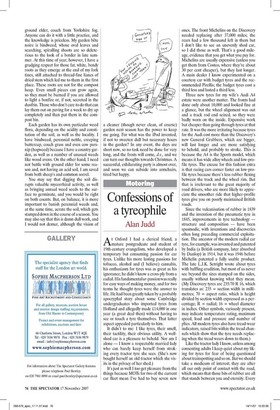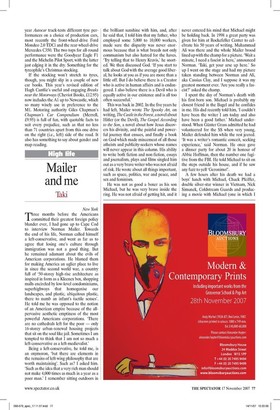Confessions of a tyreophile
Alan Judd At Oxford I had a clerical friend, a mature postgraduate and student of 19th-century evangelism, who developed a temporary but consuming passion for car tyres. Unlike his more lasting passions for tobacco, alcohol and (I believe) cannabis, his enthusiasm for tyres was as great as his ignorance; he didn't know a cross-ply from a radial. His fundamental ur-passion was really for easy ways of making money, and for two terms he thought tyres were the answer to life. He had been greatly taken by a probably apocryphal story about some Cambridge undergraduates who imported tyres from Holland and allegedly made £14,000 in one year (a great deal then) without having to see or touch a tyre themselves. That latter aspect appealed particularly to him It didn't to me: I like tyres, their smell, their tactility, their obvious utility. A wellshod car is a pleasure to behold. Nor am I alone — I know a respectable married lady who can barely keep herself from stroking every tractor tyre she sees. (She's now bought herself an old tractor which she visits in the privacy of her shed.) It's just as well I too get pleasure from the things because MOTs for two of the current car fleet mean I've had to buy seven new ones. The front Michelins on the Discovery needed replacing after 37,000 miles; the rears had a few thousand left in them but I don't like to see an unevenly shod car, so I did those as well. That's a good mileage, evidence that you get what you pay for. Michelins are usually expensive (unless you get them from Costco, where they're about 30 per cent cheaper), but they last longer. A main dealer I know experimented on a courtesy car with budget tyres and the recommended Pirellis; the budget tyres cost a third less and lasted a third less.
Three new tyres for my wife's Audi A4 estate were another matter. The fronts had done only about 10,000 and looked fine at a glance, but the wheel alignment was out and a track rod end seized, so they were badly worn on the inside. Expensive work but cheaper than going through tyres at that rate. It was the more irritating because tyres for the Audi cost more than the Discovery's new General Grabbers, which are bigger, will last longer and are more satisfying to behold, and probably to stroke. This is because the A4 is the Sports model, which means it has wide alloy wheels and low-profile tyres. The excuse for this fashion extra is that racing cars corner faster on low-profile tyres because there's less rubber flexing between the track and the wheel rim. But that is irrelevant to the great majority of road drivers, who are more likely to appreciate the smoother ride that higher-profile tyres give you on poorly maintained British roads.
Since the vulcanisation of rubber in 1839 and the invention of the pneumatic tyre in 1845, improvements in tyre technology — structure and composition — have been spasmodic, with inventions and discoveries often long preceding commercial exploitation. The ancestor of the modern radial car tyre, for example, was invented and patented by India (a British company, later absorbed by Dunlop) in 1914, but it was 1946 before Michelin patented a fully usable product. The late L.J.K. Setright wrote about tyres with baffling erudition, but most of us never see beyond the sizes stamped on the sides, usually without knowing what they mean. (My Discovery tyres are 235/70 R 16, which translates as: 235 = section width in millimetres; 70 = aspect ratio, which is height divided by section width expressed as a percentage; R = radial; 16 = wheel diameter in inches. Other symbols, variously present, may indicate temperature rating, maximum speed, load and pressure and number of plies. All modern tyres also have tread-wear indicators, raised bits within the tread channels which show that the tyre needs replacing when the tread wears down to them.) Like the tractor lady I know, unless among consenting adults I keep quiet about my liking for tyres for fear of being questioned about trainspotting and so on. But we should take a modicum of interest; they are after all our only point of contact with the road, which means that those bits of rubber are all that stands between you and eternity. Every year Autocar track-tests different tyre performances on a choice of production cars, most recently the front-wheel-drive Ford Mondeo 2.0 TDCi and the rear-wheel-drive Mercedes C350. The two tops for all-round performance were the Goodyear Eagle Fl and the Michelin Pilot Sport, with the latter just edging it in the dry. Something for the tyreophile's Christmas stocking.
If the stocking won't stretch to tyres, though, you might slip in a couple of new car books. This year's revised edition of Hugh Cantlie's useful and engaging Breaks near the Motorways (Cheviot Books, £12.95) now includes the Al up to Newcastle, which so many wisely use in preference to the ME Motoring authority Giles Chapman's Chapman 's Car Compendium (Merrell, £9.95) is full of fun, with quotable facts to suit every prejudice, such as that no less than 71 countries apart from this one drive on the right (i.e., left) side of the road. It also has something to say about gender and map-reading.





































































 Previous page
Previous page